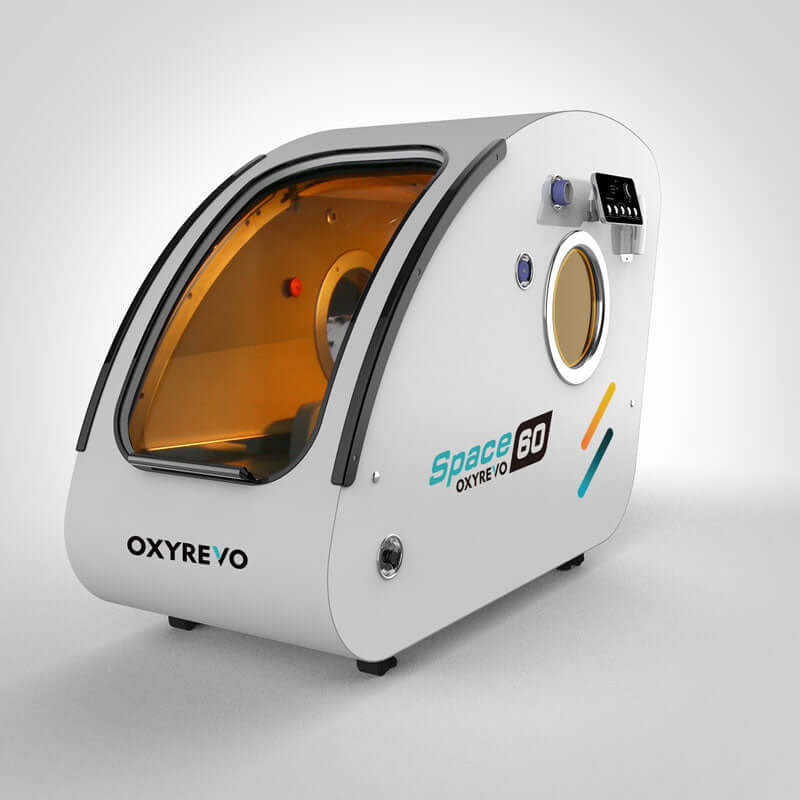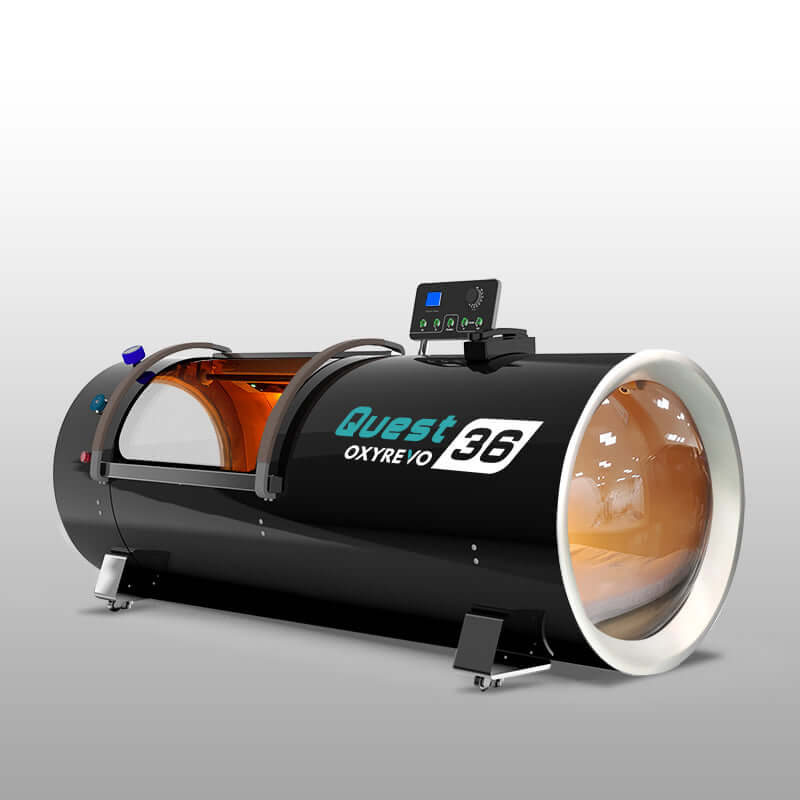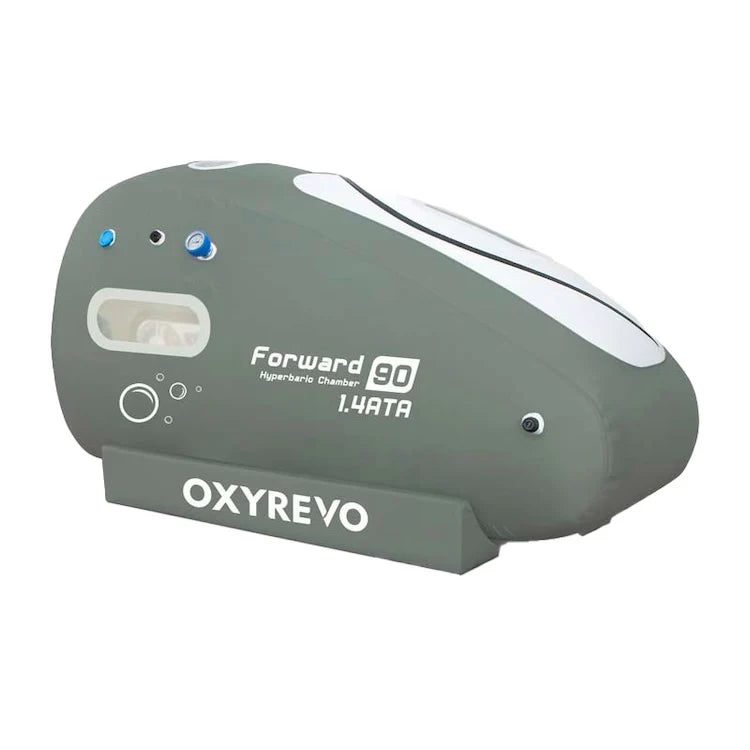Best Hyperbaric Chamber for Home Use | [2025 Update]
Best Hyperbaric Chamber For Home Use

⚕️ Medical Disclaimer: This content is for educational purposes only. Hyperbaric Oxygen Therapy (HBOT) carries medical risks and should only be used under professional supervision. Always consult a licensed healthcare professional before starting any HBOT program. For detailed setup, safety, and practical tips, see our Hyperbaric Oxygen Therapy FAQs for Home & Wellness Use
Recovathlete, being Hyperbaric Chamber Retailer, has helped countless clients—from pro athletes to people managing chronic conditions—set up home HBOT safely.
Imagine stepping into your personal oxygen sanctuary at home. Your cells bathed in pressurized, healing oxygen. Inflammation fades. Recovery accelerates. Mental clarity improves.
But choosing the best hyperbaric chamber for home use isn’t as simple as clicking “add to cart.” You need to think about safety certifications, pressure ratings, daily usability, and your actual therapy goals.
This guide will help you make an informed choice with professional, medically responsible recommendations.
Key Takeaways
- Select your chamber based on goals—recovery, energy, or chronic support—and match pressure range and design accordingly.
- Consider use frequency: daily needs quiet, durable chambers; weekly use suits semi-rigid; occasional use fits soft, budget-friendly models.
- Prioritize safety: verify FDA clearance, dual gauges, emergency valves, medical-grade materials, and reliable customer support.
- Balance comfort and space: check interior size, noise levels, portability, storage needs, and ease of entry and exit.
- Set a realistic budget: soft $2K–6K, semi-rigid $4K–10K, rigid up to $50K—choose what aligns with your lifestyle and goals.
Table of Contents
How to Choose the Best Hyperbaric Chamber for Home
Start by defining your goals. As someone who’s helped athletes, biohackers, and patients choose wisely, these are the questions we recommend answering first:
🎯 What’s Your Primary Goal?
- Athletic Recovery: 1.5 ATA sessions can reduce soreness by ~30% with consistent use. Best choice: Rigid or semi-rigid chambers for daily stability. (Des Moines Hyperbarics)
- Cognitive & Energy Support: A Nature study showed 40 sessions at 1.5 ATA improved memory and attention in post-concussion patients. Soft or semi-rigid chambers work well here. (Nature Study)
- Chronic Condition Support: For migraines, long COVID, autoimmune flares: prioritize daily reliability and robust safety features. FDA-cleared, rigid or semi-rigid designs are best.
Pro Tip: Write your top goals down first. It’s the #1 way to avoid paying for features you don’t need—or skipping ones you do.
🎯 How Often Will You Use It?
- Daily: Quiet compressors, durable zippers, easy controls.
- Weekly: Semi-rigid or rigid models.
- Occasional: Soft chambers for budget and portability.
🎯 Where Will You Put It?
- Dedicated Room: Ideal for rigid chambers.
- Multipurpose Space: Soft or semi-rigid models fold away.
- Clinics or Shared Use: Semi-rigid or rigid for easy cleaning and repeated use.
Client Scenario: Sarah, a triathlete, chose a semi-rigid model she could collapse for travel but set up in her home gym for daily use.
🎯 What’s Your Budget?
- Soft Chambers: ~$2,000–$6,000
- Semi-Rigid: ~$4,000–$10,000
- Rigid: ~$10,000–$50,000
Remember: The best hyperbaric chamber for home is the one that actually fits your lifestyle and goals.
Key Factors to Consider When Buying the Best Hyperbaric Chamber for Home Use
When choosing the best hyperbaric chamber for home use, think carefully about these critical factors. Each will impact your safety, comfort, and long-term satisfaction.
Professional Tip: Don’t just focus on price. The best hyperbaric chamber for home balances safety, comfort, pressure capability, and budget.
🏗️ Design
- Rigid Chambers: Clinic-quality up to 2.0 ATA. Ideal for athletes or chronic condition management. Built-in seats, requires dedicated space.
- Semi-Rigid Chambers: Combines strength with portability. Often 2.0 ATA capable. Suits families or small clinics.
- Soft Chambers: Lightweight, portable, budget-friendly. Typical range is 1.3–1.5 ATA. Great for general wellness.
⚙️ Pressure Range
Most home-use chambers operate at 1.3–1.5 ATA, which is considered safe and effective for general wellness and mild therapeutic use. Higher pressures (up to 2.0 ATA) are available in some advanced models but may require additional safety considerations and professional guidance.
Source: Des Moines Hyperbarics
📏 Chamber Size and Comfort
The interior dimensions affect comfort, especially for longer sessions. Larger chambers offer more space to move or accommodate multiple users but require more room in your home and may cost more.
🏋️ Build Quality and Materials
Look for chambers made from durable, medical-grade, non-toxic materials. Features like heat-welded seams, reinforced zippers, and quality valves enhance safety and longevity.
🤝 Ease of Use
Consider how easy it is to enter and exit the chamber, operate controls, and monitor pressure. Chambers with large entryways, clear control panels, and user-friendly designs are preferable for home use.
💨 Oxygen Delivery System
Check whether the chamber comes with a high-quality oxygen concentrator and whether it delivers oxygen efficiently and quietly.
🔇 Noise Level
Quieter compressors and valves contribute to a more comfortable experience, especially in home environments.
⚠️ Safety Features
Look for dual pressure gauges, emergency pressure relief valves, and easy-to-reach controls to ensure user safety during operation. Always verify safety certifications or FDA clearance for medical use.
FDA HBOT Device Classification
🚚 Portability and Storage
If you need to move or store the chamber, consider its weight, disassembly process, and storage requirements. Soft models are typically the easiest to move and store.
📜 Certification and Compliance
Ensure the chamber meets relevant safety standards and guidelines. For medical research or treatment, FDA clearance or compliance with local regulations is essential.
📞 Warranty and Customer Support
A reliable warranty and responsive customer service are important for peace of mind and long-term use. Check warranty duration and support responsiveness.
💰 Budget
Prices vary widely. Soft chambers typically start around $2,000–$6,000, semi-rigid models range from $4,000–$10,000, and rigid clinic-grade units can reach $50,000. Balance quality, features, and affordability to suit your needs.
When choosing the best hyperbaric chamber for home use, think carefully about these critical factors. For a full rundown on uses, costs, and safety, check Hyperbaric Chambers: Uses, Costs, Safety & Where to Buy
Overview of the Best Hyperbaric Chambers for Home Use
Choosing the best hyperbaric chamber for home use depends on your specific needs, such as comfort, size, pressure range, and budget. Below are the top options based on expert reviews and market offerings, complete with features, pros, and cons to help you decide.

Oxyrevo Space60 2.0 ATA HBOT Chamber
Best for Comfort
- Pressure: Adjustable 1.3–2.0 ATA
- Size: Spacious (79" long, 34" wide), fits through standard doorways
- Features: Large windows reduce claustrophobia, 10L oxygen concentrator (up to 97% oxygen)
- Price: ~$42,999
Pros:
- Exceptional comfort: Spacious interior (79" long, 34" wide) allows both seated and reclining positions, making sessions more comfortable for longer durations
- Adjustable pressure: Offers a pressure range from 1.3 to 2.0 ATA, suitable for various therapy needs
- User-friendly design: Large windows reduce claustrophobia, and the chamber fits through a standard doorway for easier installation
Cons:
- High price: At $42,995, it is one of the more expensive options for home use
- Large size: Requires significant space at home, which may not suit small apartments or limited spaces
- Heavy: The hard-shell design weighs over 1,300 lbs (600 kg), making it difficult to move once installed
The Oxyrevo Space60 2.0 ATA HBOT Chamber features a spacious 79" x 34" design for comfortable seated or reclining therapy, adjustable pressure from 1.3 to 2.0 ATA, a 10L oxygen concentrator delivering up to 97% pure oxygen, and large windows to reduce claustrophobia.

Oxyrevo Quest36 2.0 ATA HBOT Chamber
Best for Versatility
- Pressure: Adjustable 1.3–2.0 ATA
- Size: Large—does NOT fit through a standard doorway; requires a 38" opening
- Features: Quiet operation (≤50 dB); large windows reduce claustrophobia
- Price: ~$27,995
Pros:
- Wide Pressure Range: Adjustable from 1.3 to 2.0 ATA, allowing for both mild and higher-pressure therapies, suitable for a range of health needs
- Spacious & Durable: Large interior (89” x 36”), fits an adult and child or allows for reclining; made from stainless steel and polycarbonate for longevity and safety
- Advanced Features: Dual control panels (inside/outside), real-time digital displays (oxygen purity, humidity, temperature), and smart safety systems like door sensors and emergency valves
Cons:
- High Price: Around $29,995–$30,000, making it a significant investment for home users
- Complex Installation: Does not fit through standard doorways (requires a 38" opening or modifications), and professional installation is often needed
- Heavy & Bulky: Weighs over 770 lbs (chamber only), making relocation or setup challenging in typical home environments
The Oxyrevo Quest36 delivers customizable 1.3–2.0 ATA therapy, runs at ≤50 dB, and has large windows to ease claustrophobia. It’s spacious for home or commercial use but needs a 38″ doorway and likely professional installation.

OxyRevo Forward 90 Portable Sitting Hyperbaric Chamber
Best for Sitting/Reclining Use
- Pressure: Adjustable 1.2–1.5 ATA
- Features: Can sit, recline, or lie down; accommodates one adult and one child; quiet operation; dual pressure gauges; heat-welded seams for durability
- Price : $9499
Pros:
- Flexible Use: Allows sitting, reclining, or lying down; includes an adjustable folding chair and memory foam mattress for comfort
- Spacious & Family-Friendly: Large enough (90” x 47” x 47”) to accommodate an adult and a child together, with four large windows for light and reduced claustrophobia Learn more (OxyRevo Forward 90 Hyperbaric Chamber FAQ)
- Quiet & Safe: Operates at ≤50 dB, features dual pressure gauges (inside/outside), emergency valves, and high-quality, non-toxic materials
Cons:
- Limited Pressure Range: Standard pressure is 1.4–1.5 ATA, which may not meet needs for higher-pressure therapy
- Soft-Shell Durability: While robust for a portable chamber, it’s less durable than hard-shell models and may not last as long with intensive use.
- Bulkier Than Most Soft Chambers: While portable, its large footprint may require significant floor space compared to other soft-shell models
The OxyRevo Forward90 delivers sit-or-recline 1.4–1.5 ATA therapy at ≤50 dB, with four large windows and a memory-foam chair to ease claustrophobia. It’s lightweight and foldable for easy home or clinic use but still needs about a 90″ × 47″ setup area.

Newtowne Hyperbarics C4-27 Home Hyperbaric Chamber
Best for Budget-Friendly Home Use
- Pressure: ~1.3 ATA
- Price: ~$4,495
- Features: Reliable, widely used among athletes and wellness clinics
Pros:
- Affordable and portable: Among the most budget-friendly options, with a lightweight and compact design that’s easy to transport and set up
- Ease of use: Operable from both inside and outside, allowing independent sessions without assistance
- FDA-cleared and safe: Manufactured in the USA with a 100% safety record and over 20 years of experience
Cons:
- Limited space: Smaller diameter (27"), best suited for single users and may feel cramped for larger individuals
- Requires attendant for zipping: Some users may need help sealing the chamber, especially those with mobility issues
- Basic features: Fewer advanced features compared to more expensive models, such as limited pressure adjustability and smaller windows.
The Newtowne C4-27 delivers 1.3 ATA therapy via an ultra-quiet HK80 compressor, dual inside/outside valve controls, and a bright interior window to ease claustrophobia. Weighing just 19 lb and fitting users up to 6′, it’s travel-friendly but needs a 27″-diameter setup and a prescription.

OxyNova 7 Personal Hyperbaric Chamber
Best for Portability and Ease of Use
- Pressure: 1.4 ATA
- Features: Lightweight construction, orthopedic mattress, high airflow compressor, easy assembly
- Price: ~$23,995
Pros:
- Lightweight & Portable: Weighs just 31–37 lbs, making it one of the most portable and easy-to-install chambers available
- User-Friendly: Simple manual controls, easy entry/exit with triple-zipper design, and can be operated solo from inside or outside
- Spacious for a Soft Chamber: 90” long with a 28–29.5” diameter, offering more room than most soft-shell models and accommodating a wide range of users
Cons:
- Lower Pressure: Maxes out at 1.4 ATA, which is effective for mild HBOT but not suitable for those requiring higher-pressure therapy
- Fewer Advanced Features: Lacks digital displays, internal communication systems, or integrated oxygen purity monitoring found in higher-end models
- Limited Oxygen Delivery: Oxygen concentrator is typically optional and not as powerful as those provided with hard chambers
The OxyNova 7 delivers 1.4 ATA mild‐HBOT at 160 L/min airflow and <60 dB noise, with eight double‐layered windows, dimmable LEDs, and a premium orthopedic mattress for comfort. It’s ultra-portable at 31.9 lb with a 10 min setup for home, travel, or clinic use but needs a 28″ Ø × 90″ footprint and a prescription.
Popular Brands for Home Use
Professional Note: For athletes and performance-focused buyers, the Newtowne Hyperbarics C4-27 and Oxyrevo models are highly regarded for reliability and performance.
Best Hyperbaric Chamber for Home Use Comparison
| Pressure (ATA) | 1.3 ATA | 1.2–1.5 ATA | 1.4 ATA | Upto 2.0 ATA | Upto 2.0 ATA | 1.3–2.0 ATA |
| Price | $4,495 | $9,499.00 | 25,500.00 | 24,999.00 | $27,999.00 | $42,999.00 |
| Notable Features | Affordable, reliable | Sitting/reclining, quiet, flexible | Portable, easy to use, high airflow | Compact and user-friendly design | Strong walls, portable storage, versatile use | Spacious, adjustable, high comfort |
| Best For | Budget, Athletes | Sitting/Reclining | Portability | Smaller Individuals or Beginners | Versatility | Comfort |
Summary
Set clear goals first: muscle recovery, mental focus, or chronic-condition support. Choose chamber type by use frequency and space—rigid for daily, high-pressure use; semi-rigid for mixed needs; soft for portability and budget.
Budget ranges:
- Soft: $2K–$6K
- Semi-rigid: $4K–$10K
- Rigid: up to $50K
Key factors:
- Pressure: 1.3–1.5 ATA standard; up to 2.0 ATA with guidance
- Size & Comfort: Bigger interior needs more floor space
- Build: Medical-grade materials, heat-welded seams, quality valves
- Ease of Use: Wide entry, simple controls, plug-and-play setup
- Safety: Dual gauges, relief valves, FDA clearance
- Noise & Air: Quiet compressors, good filtration
Top picks cover comfort, versatility, portability, and budget. Balance goals, space, and price to find your ideal home HBOT chamber
Frequently Asked Questions
Can I buy a personal hyperbaric chamber for home use, and is a prescription required?
Yes. In the US, home chambers are FDA Class II devices. You need a prescription from an MD or DO to purchase and use one at home. Some vendors include telehealth consults to secure your script. A separate prescription is required for any oxygen concentrator.
What should I look for in a "good" home hyperbaric chamber?
Use this checklist: Pressure range (1.3–1.5 ATA soft; up to 2.0 ATA rigid) • Internal size & windows • Portability vs. sturdiness • Quiet compressor • Easy dual-zipper controls • Solid warranty • Medical-grade, non-toxic materials
What’s the difference between OxyNova, Newtowne, Oxyrevo, Macy Pan Hyperbaric Chambers?
- OxyNova: Premium Canadian brand, luxury build, top safety record, lifetime warranty.
- Newtowne Hyperbarics: Affordable, durable, USA-made soft chambers, FDA-cleared, strong safety history.
- Oxyrevo: Versatile Chinese brand, wide range of models (soft/hard shell), large windows, budget-friendly.
- Macy Pan: Cost-effective Chinese manufacturer, many customizable options, rapid delivery, popular for multi-user setups.
Is using a hyperbaric chamber at home safe, and who should avoid it?
Soft-shell chambers (1.3–1.5 ATA) are safe when used per instructions. Avoid if you have uncontrolled lung disease (e.g., COPD, pneumothorax), ear/sinus issues that block equalizing, severe claustrophobia, high fever, or pregnancy without approval.
Are home hyperbaric chambers safe for children or elderly individuals?
Yes, with supervision. Children need a caregiver inside for comfort and ear-pressure equalizing. Elderly users must assess mobility and health conditions. In all cases, a physician’s prescription and clearance are essential before use.
Is it safe to use my iPhone or other electronics inside a home hyperbaric chamber?
No. The oxygen-rich, pressurized environment greatly increases fire/explosion risk from electronics. Keep all battery-powered devices outside the chamber to ensure a safe session.
What is the upfront cost of a home hyperbaric chamber?
Soft-sided home chambers range $4,000–$7,000 for basic models. Mid-range units run $8,000–$15,000. High-end soft or rigid units can exceed $25,000. Rentals cost about $1,000–$2,500/month.
How much does each session at home actually cost?
Electricity is your main ongoing expense. Compressors use power similar to a space heater. At average US rates, a 60-minute session usually costs under $1—vastly cheaper than clinic fees of $100–$300/session.
What are the common problems or complaints with home hyperbaric chambers?
Users cite high upfront cost; feeling confined; compressor noise; difficulty equalizing ear pressure; bulky setup/takedown; and finding a knowledgeable prescribing doctor. Proper prep, noise dampening, and vendor support can help.
Can I use my home hyperbaric chamber every day?
Yes—many users do. A common protocol is 5–7 sessions weekly, each 60–90 minutes. Daily therapy maximizes benefits for recovery or chronic support. Always follow your physician’s guidance on frequency and duration.
What does 1.5 ATA therapy do, and how effective are home units?
1.5 ATA adds 50% more pressure than sea level, boosting oxygen dissolved in blood and tissues. Benefits include reduced inflammation, stem-cell stimulation, faster healing, and improved cognition. Studies and reports validate its use at 1.3–1.5 ATA.
Are there studies supporting the effectiveness of home hyperbaric chambers?
Yes. Research on mild HBOT (1.3–1.5 ATA) documents benefits for recovery, cognition, and chronic conditions. Early FDA-approved uses were specific, but newer peer-reviewed studies in journals like Undersea & Hyperbaric Medicine support broader wellness claims.
What’s the single most important piece of advice when considering a home hyperbaric chamber?
Consult a qualified healthcare provider. A physician experienced in hyperbaric medicine will confirm if HBOT suits your needs, write the necessary prescriptions, and guide optimal pressure settings and session schedules. Never self-prescribe.







